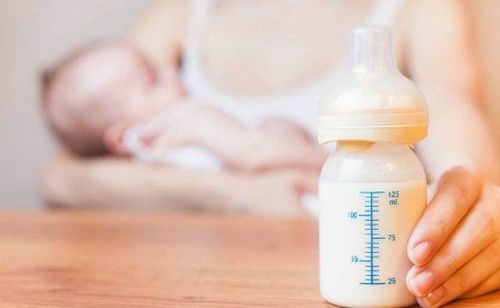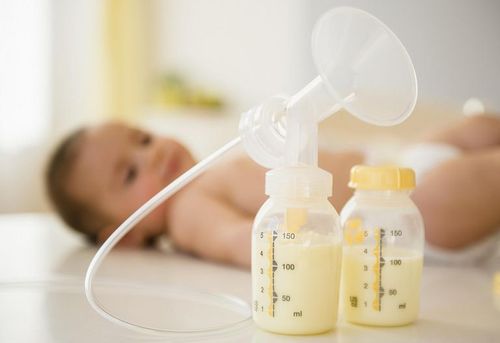This is an automatically translated article.
The article is professionally consulted by an Obstetrician and Gynecologist - Department of Obstetrics and Gynecology - Vinmec Phu Quoc International General Hospital
Breast milk is the best source of nutrition for the health and development of infants and young children. After birth, breast milk has changes in composition, nutrition and color.
1. Breast milk
Breast milk is the best source of nutrition for the comprehensive development of infants and young children. Breast milk includes:Colostrum: is breast milk produced during pregnancy and begins to be excreted in about 2-3 days after giving birth. Lactation: secreted a few days after birth. The amount of milk secreted is high and the mother feels the breast is full and heavy. Colostrum: is the milk secreted by the mother at the beginning of breastfeeding. Colostrum has a slightly thick color and is rich in protein, lactose and other nutrients. Babies are always getting plenty of colostrum and have already received enough water so they don't need to drink extra water when they're 4-6 months old. Last milk: is the milk secreted at the end of the feeding. The final milk is clearer than the fore milk because it contains more fat. Fat in milk provides a lot of energy for babies. Therefore, mothers should let their babies finish their milk before they stop breastfeeding or switch to another breast.

Sữa non xuất hiện trong khoảng 2-3 ngày sau đẻ.
2. Changes in the composition of breast milk
2.1 Breast milk changes according to a child's stage of development
Breast milk always changes in each postpartum period to meet the needs of the baby's development. The stages of change include:2-3 days postpartum: breast milk in the first few days after birth is called colostrum. Condensed colostrum has a dark and light yellow color, gradually thinning in the following days. Colostrum contains less fat, lactose and water-soluble vitamins, but is rich in protein and fat-soluble vitamins, especially immune cells. Therefore, babies who drink colostrum from mothers will increase their resistance against diseases. After 5 days: breast milk will turn to mature milk stage, also known as let-down. At first, the amount of mature milk is very large because the milk glands have not received the needs of the baby. Mothers will often feel full breasts and wet clothes due to milk leakage. 6 weeks postpartum: breast milk becomes real mature milk. Mature milk is milky white, thinner than colostrum, but still has a certain consistency. Ingredients in mature milk contain many proteins, fats, immunostimulants, carbohydrates, vitamins and minerals, enzymes and hormones to meet the nutritional needs of children. From the 2nd to the 5th month after birth: still mature milk with the same composition as before. However, as the baby gets older, the fat content in breast milk decreases. 6 to 10 months postpartum: breast milk at this time still contains many nutrients and antibodies needed for the baby. However, it will not meet the nutritional needs of children. Therefore, if only breast-feeding exclusively as 6 months before, the baby will develop slowly. The 11th to 18th month postpartum: at this stage, breast milk still contains essential nutrients such as fat, vitamins, and protein. However, in addition to breastfeeding, it is necessary to alternate weaning foods and not completely cut off breast milk from the child's diet. After 2 years: breast milk always has the necessary nutrients for the baby. However, the weaning of breast milk for children at this time is completely suitable for the mother's convenience.

Sữa mẹ thay đổi theo giai đoạn phát triển của trẻ
2.2 Changes in each feeding
With each feeding, the breast milk also changes. The first milk flow is milky juice that contains a lot of protein and lactose to quench the thirst of the child. During feedings, fat and energy levels gradually increase and peak at the end of the feed. At this time, milk is clearer than colostrum because it contains more fat to help satisfy hunger.
Sữa mẹ có sự thay đổi trong từng lần bú
2.3 Changes according to the weather
Breast milk changes to adapt to the climate. In hot weather, milky juices will be produced more than usual to help the baby stay hydrated. In addition, if the mother gives birth to a boy, the energy will be 25% more than that of a girl.
In short, breast milk is always an essential nutrient for a child's comprehensive development. From birth until 24 months of age, breast milk is constantly changing to meet the needs of the baby through each stage of development. Proper understanding of the changes in breast milk will help mothers adjust the right nutrition for their babies and use this source of nutrition in a reasonable way to keep the baby healthy.
Please dial HOTLINE for more information or register for an appointment HERE. Download MyVinmec app to make appointments faster and to manage your bookings easily.













